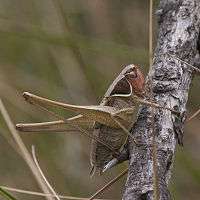Sepiana sepium
Sepiana sepium, common name sepia bush-cricket, is a species of bush crickets belonging to the family Tettigoniidae. It is the only species within the monotypic genus Sepiana.[1]
| Sepia bush-cricket | |
|---|---|
| S. sepium, male | |
.jpg) | |
| S. sepium, female | |
| Scientific classification | |
| Kingdom: | |
| Phylum: | |
| Subphylum: | |
| Class: | |
| Order: | |
| Suborder: | |
| Family: | |
| Subfamily: | |
| Genus: | Zeuner, 1941 |
| Species: | S. sepium |
| Binomial name | |
| Sepiana sepium (Yersin, 1854) | |
| Synonyms | |
| |
Distribution
This widespread species is present from southwestern to southeastern Europe and in the Near East. It can be found from Portugal and Spain, southern France, Italy and the Balkan Peninsula along the Black Sea to Turkey and to south-west Russia.[2][3]
Habitat
These bush crickets usually live in not too xerothermic areas on the edge of the forests and in bushland, but also on grassy meadows.[4]
Description

Sepiana sepium can reach a length of 20–27 millimetres (0.79–1.06 in). The ovopositor reaches 10–15 millimetres (0.39–0.59 in). These bush crickets have very long enlarged hind legs, with small spines on the lower legs. The ground colour of the body ranges from gray-brown to reddish. The sides of the pronotum are almost triangular-shaped, usually black or dark brown, and they are clearly delineated by a bright longitudinal line. The head is usually reddish coloured. Above the eyes there is a dark patch, which is crossed by a whitish line. The legs are dark brown or dark gray. On the hind legs there is a dark brown stripe. The cerci of the males are flattened. In the females the 6th and 7th abdominal segments have a pair of cusps. This species is quite similar to Metrioptera roeselii.[4][5]
The bush crickets of this species, similarly to the species within the genus Platycleis, have the largest testicles in proportion to body mass of any animal recorded.[6][7][8]
Biology
Adults appear from July to September. Their vocals consist of highly scratching sounds, which are performed at a very short distance from one another.[1][4]
References
- Orthoptera Species File
- Fauna europaea
- Catalogue of life
- Linnea
- Heiko Bellmann: Der Kosmos Heuschreckenführer. Die Arten Mitteleuropas sicher bestimmen. Franckh-Kosmos Verlags GmbH & Co. KG, Stuttgart 2006, ISBN 3440104478
- David E. Vrech, Paola A. Olivero, Camilo I. Mattoni, Alfredo V. Peretti Testes Mass, but Not Sperm Length, Increases with Higher Levels of Polyandry in an Ancient Sex Model
- Vahed, K.; Parker, D. J.; Gilbert, J. D. J. (2010). "Larger testes are associated with a higher level of polyandry, but a smaller ejaculate volume, across bushcricket species (Tettigoniidae)". Biology Letters. 7 (2): 261–4. doi:10.1098/rsbl.2010.0840. PMC 3061181. PMID 21068028.
- Biggest testicles record set by bushcricket